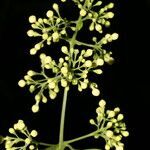usually trifui cate, many-flowered, bracteate, the sympodia variable in length, often elongate, stout, 2-5 cm long, usually conspicuously flattened and sulcate, brownish, furrowed in drying, densely puberulent or glabrate; peduncles 1-6 cm long, terete, furrowed in drying, brownish, usually puberulent, sometimes glabrate; pedicels slender, 1-2 mm long, puberulent, the lateral ones 1-2 mm long, the central ones shorter or obsolete, puberulent; bracts large and foliaceous, similar to the leaves but smaller, mostly lanceolate, 6-10 cm long and 1-2 cm wide, acuminate at both ends, densely puberulent on both surfaces and with many glandular disks along the midrib; bractlets linear or narrow-lanceolate, to 16 mm long and 7 mm wide, caducous; prQphylls linear, 1-5 mm long, caducous. Flowers with the calyx obconic-campanulate, ca. 2.8 mm long and 2.3 mm wide, puberu-lent, truncate or minutely 4-apiculate; corolla hypocrateriform, pale-or lemon-yellow to white, the tube narrow-cylindric, 5-7.5 mm long, ampliate above, glabrous outside, pubescent within, the lobes 4, oblong-lingulate, ca. 4.1 mm long and 2.3 mm wide, obtuse; stamens 4, inserted ca. 2.8 mm below the mouth of the corolla-tube, long-exserted in the staminate flowers or included in the pistillate, the filaments flattened, 0.7-10.4 mm long, somewhat pilose; pistil included or equaling the corolla-tube in the staminate flowers, long-exserted in the pistillate, the style 5.2-12 mm long, glabrate, the stigma branches 0.5-2.6 mm long, the ovary dark, oblong, ca. 1 mm long and 0.5 mm wide, apically flattened and um-bilicate, glabrous, 4-lobed, 4-celled. Fruit yellow or orange, oblong, tetragonal, 9-10 mm long and ca. 7 mm wide, flattened and conspicuously umbilicate apically, smooth and shiny, drying brown, smooth and shiny, gibbous at the middle, 4-seeded; seeds white; fruiting-calyx large and indurated, cupuliform, usually very distinctly tetragonal, basally flat and truncate, 2-5 mm long and 7-10 mm wide, externally puberulent, glabrous and shiny within, its rim usually very regular and truncate, fitting closely over the base of the mature fruit like the cup of an acorn or subincluding the very immature fruit, the pedicels greatly incrassate and acutely tetragonal in fruit, ampliate to ca. 1.2 mm above.
More
Shrub or small tree to 10 m tall or vine-like; trunk straight, erect, cylindric; bark grayish-white, minutely scored vertically with shallow confluent furrows and scaling off in small plates between the furrows; branches ascending, irregularly opposite, almost white; wood creamy-white, with a somewhat aromatic odor; branchlets slender or rather stout, elongate, obtusely tetragonal or subterete, flattened and ampliate at the nodes, usually conspicuously flattened and sulcate toward the tips, gray-green or brownish, densely puberulent, rarely glabrate, often becoming furrowed in drying. Leaves opposite, membranous or chartaceous, entire, lanceolate or oblong to oblong-lanceolate or obovate, 9-18 cm long, 3-8 cm wide, acute to long-acuminate or caudate, basally acute or acuminate and some-times narrowly attenuate into the petiole, dark-green above, paler beneath, black-ening in drying, densely roughened-puberulent on both surfaces, especially along the midrib and secondary veins, probably glabrescent, densely and minutely glandular-punctate beneath, usually with numerous glandular disks of varying dimensions scattered on the lamina along both sides of the midrib beneath, dis-appearing upwards, secondary veins 8-12 pairs, mostly prominent on both sur-faces, minor veins slender and delicate but usually conspicuous beneath; petioles slender or stoutish, weak, 5-13 mm long, spreading, puberulent or glabrate. Inflorescences axillary cymes and terminal panicles; the cymes solitary, opposite, to 10 cm long and 6.5 cm wide, half as long as the subtending leaves or less, often densely many-flowered, bracetolate, the panicles pyramidal, usually large and thyrsoid, sometimes long and narrow, to 30 cm long, basally to 21 cm wide, the branches ca. 5 pairs or numerous, opposite or approximate, 2-3 cm long,


